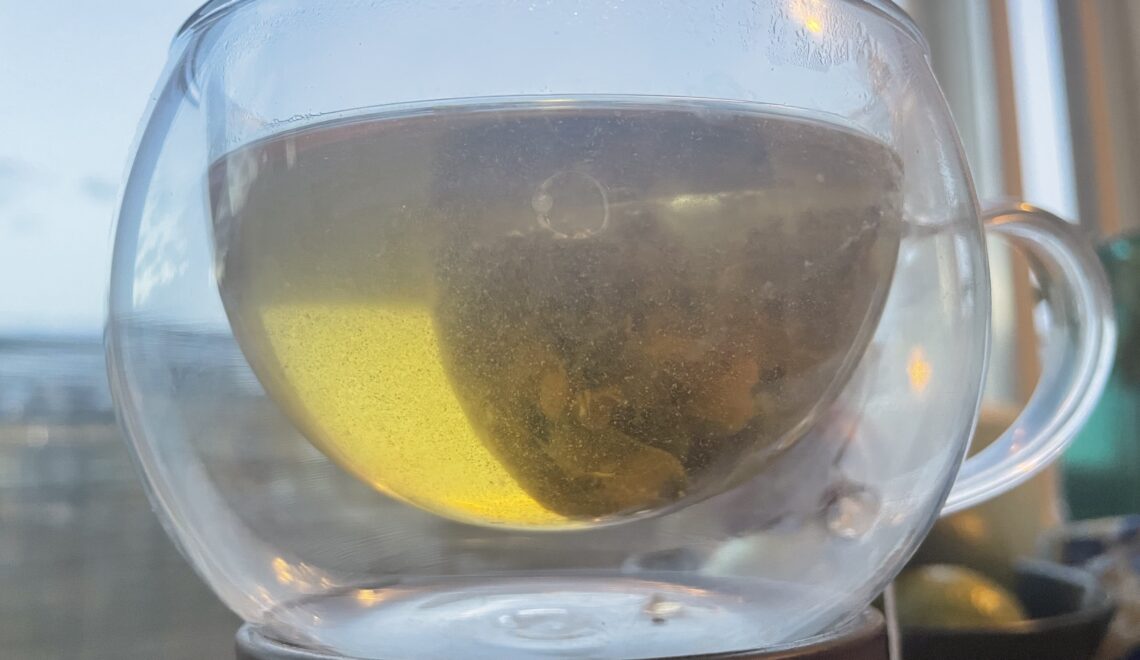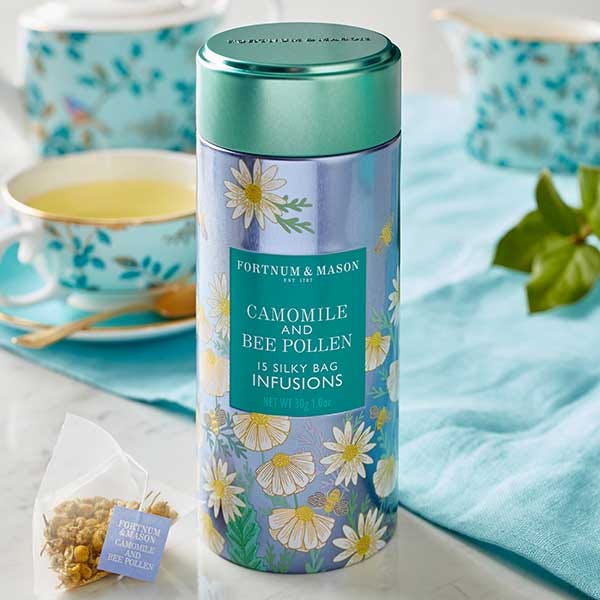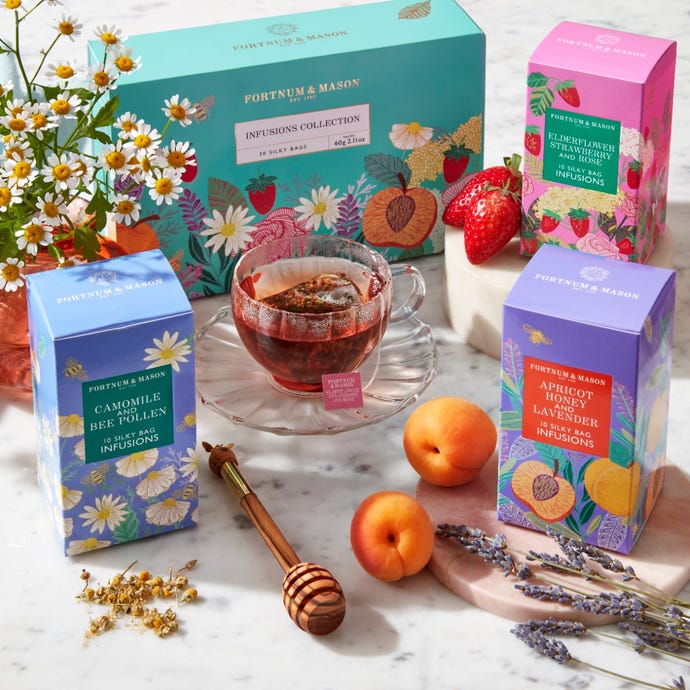
This is, by a country mile, the best chamomile tea I’ve ever tasted, and it’s all thanks to the subtle sweetness bee pollen and liquorice root lend to it.
Making the tea:
Using 1 bag per cup, and a 250ml cup, brewing for 4 minutes.
Colour: Golden chartreuse.
Clarity:
Murky, with plenty of floaters – as you can see from the top photo… (I’ve got a friend who is very put off by things like that, so if you are a lover of clear liquids, stay clear, hehehe). It also stains the cups a bit… Not as much as the Ginger & Sicilian Lemon does (and not as permanently) but be prepared to scrub if you’ve forgotten your cup for 2 days (speaking from an experience).
Ingredients:
Camomile (75%), Liquorice Root, Bee Pollen (9%), Flavourings (5%)
Taste profile: sweet floral.
Comforting, herbal, medicinal. Mellow and very rounded.
Price: £9.95 per tin, or just under £5.95 for a refill (each contain 15 tea bags).
Growing up, camomile meant “medication”. No-one, and I do mean NO-ONE under the age of 65 drank camomile voluntarily or for the pleasure of it. Camomile wraps were used to sooth wounds, joints and aching teeth, and the tea itself was thought to aid with stomach-ache, acid reflux, indigestion and a wide range of other deadly troubles. If there was nothing wrong with you, you would not be caught dead drinking it.
Some years ago, during the height of Covid restrictions, I landed at a hospital – for an operation that turned far bigger than anyone had anticipated. With strictly regulated and extremely limited human interactions and a ban on using most “common area” features like a TV, fetching a cup of camomile tea from the corridor became my primary form of entertainment. Like clockwork, around 10 times a day, I’d trek down the corridor, one hand holding together the body that had just been sawn in half, the other carrying a tiny disposable cup (100ml if you overfill it). There was no coffee or tea or other options, there were no bigger cups: just a tray of single use sugar tubes, individually wrapped camomile tea bags and hot and cold water.
My quality of life took a sudden turn for the better the morning I discovered true treasure: 3 bags of chamomile-and-mint combo teas at the bottom of the tray. Needless to say, I snapped them up immediately with zero regard for my fellow sufferers, and used them to “season” all of my next camomile teas until there was no mint flavour left to extract. But it was ok, cause somewhere between my umpteenth and hundredth cup, camomile had stopped smelling like fresh urine.
I haven’t and am likely never going to fall IN LOVE with camomile, but we’re on friendly terms, and I still believe in all the goodness it can add. And this is also the reason why I’ve never been overly tempted to get the F&M camomile (pure version), cause… I mean… how different can it be from the camomile you could get for a fraction of the price?! If you were going to get camomile, I mean, cause… I haven’t. I am not over 65 and dying.

The bee pollen “mix”, however, I was intrigued by – and it has been the biggest surprise from F&M to date. You know how people say “you either love or hate liquorice”? Well, untrue. I am fairly neutral on it, or, if pushed, perhaps a tad bit deeper on the “not a fan” side: it’s not a flavour I’d opt for, but I do not feel overly offended by it, either. What I do not enjoy is the fact that it tends to overpower.
In this combo, mixed with camomile and bee pollen, it fits. Perfectly.
The infusion itself tastes floral, well rounded (literally, it tastes smooth and cohesive) and leaves an interesting, slightly sweet aftertaste. I would not be surprised if the undisclosed 5% of “flavourings” means granulated honey, because the sweetness lingers on – longer than you’d expect from just the use of bee pollen.
Bee pollen is, also, one of those ingredients I grew up with – used for its medicinal purposes. It helps alleviate symptoms of hay fever and allergies, it aids digestion, it boosts your immune system. And much like saffron, bee pollen is worth its weight in gold. As a child, I assumed the price tag to reflect the difficulties beekeepers have having to wash it off bees’ tiny feet…
In most cases, whenever you see the addition of bee pollen – i.e. in honey – you’re lucky if the actual share reaches 2%. You’re more likely to encounter flower pollen, or granulated honey mixed with bee pollen mixed into honey to boost the “look and feel” of it. So seeing a whopping 9% on the ingredients list was also a very lovely surprise.
Do I feel the health benefits of drinking this tea? Well, yeah! And I do not care whether it’s placebo or real. The moment I start to feel like my intestines (IBS) are getting aggro, I get a cup. When my joints are inflamed and full of aggro, I get a cup. When I hear Jay sneezing and coughing near me, I get a cup. And when I feel like the world needs to become a little bit quieter, I go for Apricot, Honey & Lavender infusion because I am not yet an OAP.
In conclusion…
Is it good? Yes!
Better hot or cold? Both work, also lukewarm is the recommended temperature for healing purposes.
How often do I reach for it? For fun, rarely; for healing: whenever needed.
Worth the money? Yes, and though it’s not my favourite flavour, it’s the worthiest one of all F&M teas and infusions to date. It is objectively good.
Would I buy again? Yes, if I ever ran out, which is not likely to happen (this is my most stockpiled tea!).
Would I recommend it? Yes, without a doubt.
IT IS for you if you already like camomile, or you do not like it, but want to learn to like it for health benefits. It is also for you if you like gentle sweetness in your drinks while staying away from sugar.
It IS NOT for you if you want a tea purely for its taste (and you hate camomile with gusto).
It’s currently all sold out, and with F&M, you never know whether something is actually coming back or not. Until then, it’s a part of a special edition gift box combo (which I’d highly recommend getting) – which contains, in addition to the Camomile & Bee Pollen infusion, also my absolute favourite, the Apricot, Lavender and Honey infusion and the “this is what it feels like to drink your grandma’s livingroom decore” of all teas, Elderflower, Strawberry & Rose – which I am still having extremely complicated feelings about.






